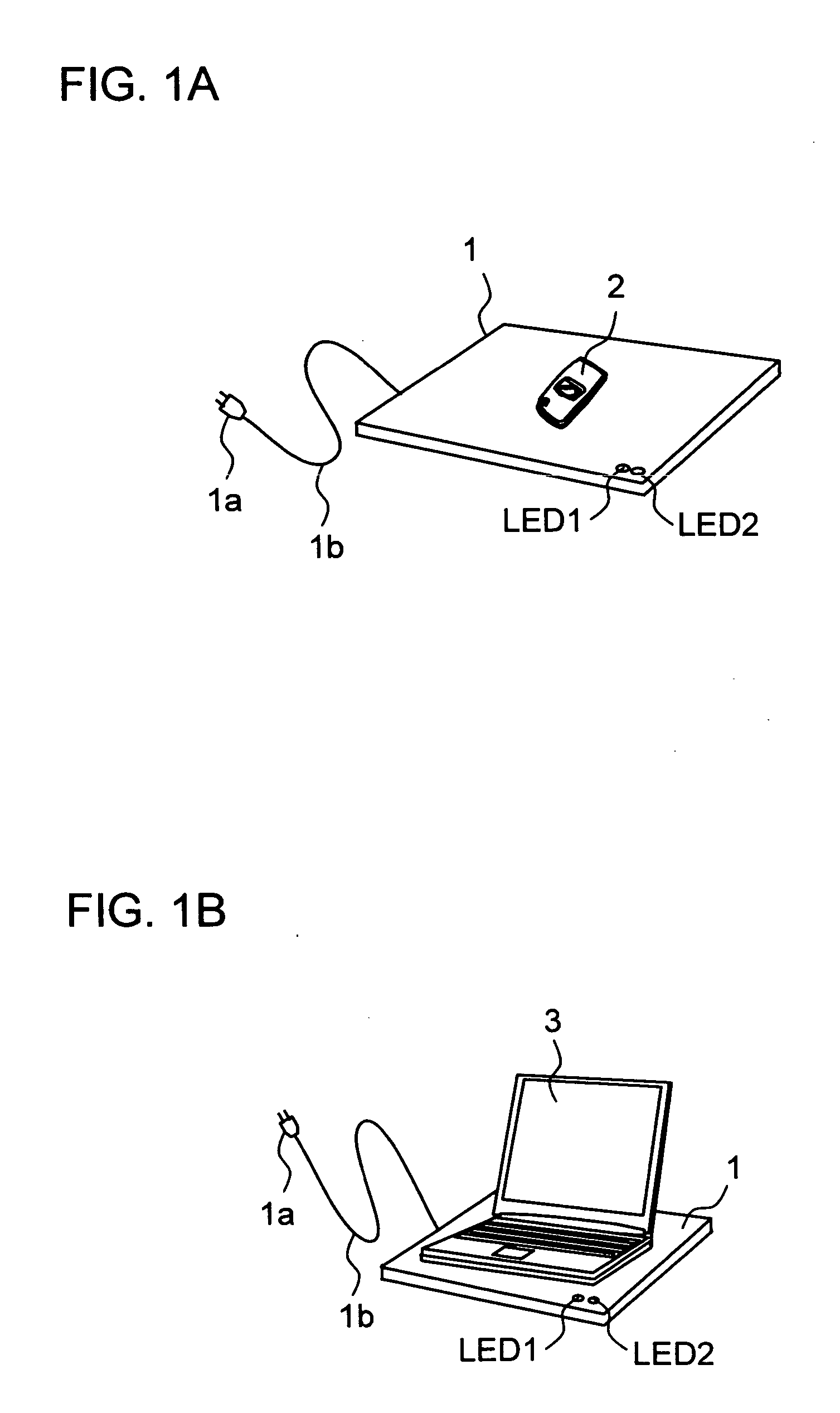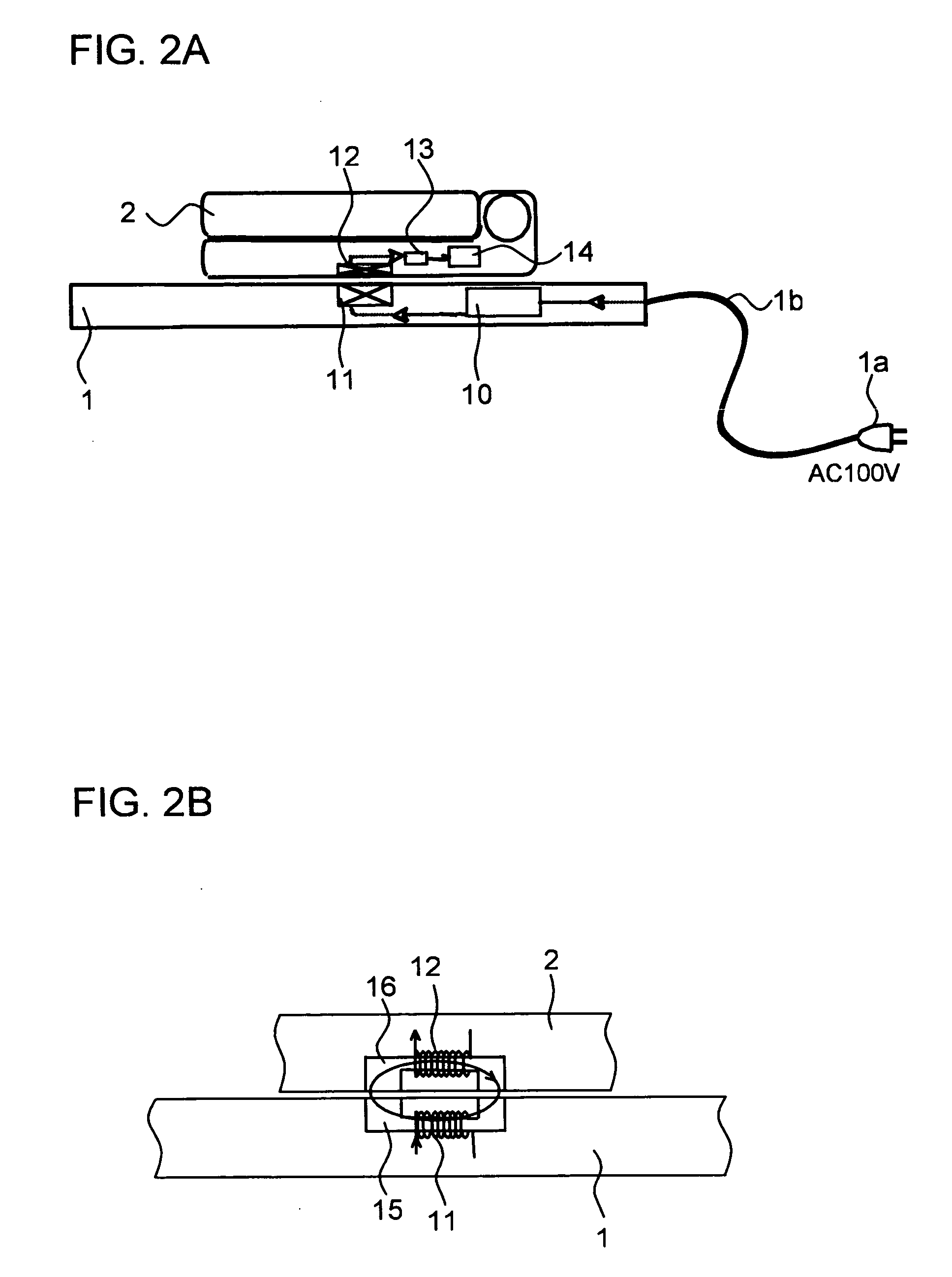Power supply system
a power supply system and power supply technology, applied in fixed transformers, transportation and packaging, liquid/fluent solid measurement, etc., can solve the problems of no compatibility among ac adapters, and flood of houses with many ac adapters, so as to save space
- Summary
- Abstract
- Description
- Claims
- Application Information
AI Technical Summary
Benefits of technology
Problems solved by technology
Method used
Image
Examples
first embodiment
[0067]FIG. 3 is a block diagram showing an electric configuration of a power supply system of the present invention. In FIG. 3, the same constituents as in FIGS. 1A, 2A, and 2B are attached with the same symbols and descriptions thereof will not be given herein.
[0068] In FIG. 3, a commercial power supply (AC 100 V) is externally fed from the AC plug 1a through the cord 1b, and the supplied AC 100 V is full-wave rectified in a rectification circuit 21 in the primary side circuit 10 and thereafter smoothed in a smoothing circuit constituted of a coil L1 and a capacitor C1 so as to be converted into a DC voltage. A pulse voltage obtained by subjecting the DC voltage to switching in a switching circuit 22 is supplied to the primary side coil 11 through transistors (power change-over section) TR11, TR12, and TR13.
[0069] All of the transistors TR11, TR12, and T13 are NPN-type transistors, and collectors thereof are all connected to an output terminal of the switching circuit 22. An emitt...
second embodiment
[0090]FIG. 5 is a block diagram showing an electric configuration of a power supply system of the present invention. In FIG. 5, the same constituents as in FIG. 3 are attached with the same symbols and descriptions thereof will not be given herein. The power supply system shown in FIG. 5 is different from the power supply system shown in FIG. 3 in that a primary side coils 11x, 11y, and 11z are provided instead of the primary side coil 11 of the power transmission apparatus 1. The three primary side coils are attached with the symbols 11x, 11y, and 11z in the descending order of the number of turns thereof, and one ends thereof are all grounded. Other end of the primary side coil 11x is connected to the emitter of the transistor TR11; other end of the primary side coil 11y is connected to the emitter of the transistor TR12; and other end of the primary side coil 11z is connected to the emitter of the transistor TR13. The coils are provided with a tap d (on the primary side coil 11x)...
third embodiment
[0093]FIG. 6 is a block diagram showing an electric configuration of a power supply system of the present invention. In FIG. 6, the same constituents as in FIG. 3 are attached with the same symbols and descriptions thereof will not be given herein. The power supply system shown in FIG. 6 is different from the power supply system shown in FIG. 3 in that primary side coils 11a and 11b are provided instead of the primary side coil 11 of the power transmission apparatus 1, and secondary side coils 12a and 12b are provided instead of the secondary side coil 12 of the portable telephone 2.
[0094] In the power transmission apparatus 1 shown in FIG. 3, the demodulation circuit 36 and the carrier wave oscillation circuit 37 are connected to the tap c of the primary side coil 11. However, in the power transmission apparatus 1 shown in FIG. 6, the demodulation circuit 36 and the carrier wave oscillation circuit 37 are connected to one end of the primary side coil 11b, and the other end of the p...
PUM
 Login to View More
Login to View More Abstract
Description
Claims
Application Information
 Login to View More
Login to View More - R&D
- Intellectual Property
- Life Sciences
- Materials
- Tech Scout
- Unparalleled Data Quality
- Higher Quality Content
- 60% Fewer Hallucinations
Browse by: Latest US Patents, China's latest patents, Technical Efficacy Thesaurus, Application Domain, Technology Topic, Popular Technical Reports.
© 2025 PatSnap. All rights reserved.Legal|Privacy policy|Modern Slavery Act Transparency Statement|Sitemap|About US| Contact US: help@patsnap.com



